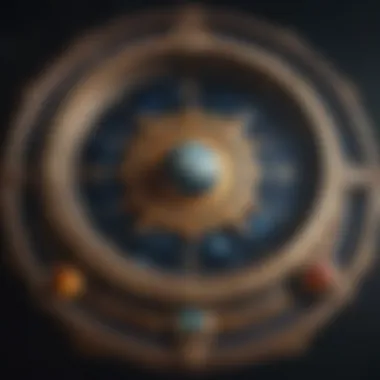Understanding the Whole Zodiac Chart: A Deep Dive


Intro
The zodiac chart serves as a map to understanding ourselves and others. Each element within this chart contributes to our unique personality, behavior, and life experiences. Recognizing these components is significant for personal growth and interpersonal relationships. This section will present foundational knowledge of the zodiac, diving into its core elements and meanings that pave the way for deeper exploration.
Understanding the Zodiac
Overview of Zodiac Signs
The zodiac consists of twelve signs, each linked to specific date ranges throughout the year. These signs are divided into three modalities: cardinal, fixed, and mutable. Each sign brings its own flavor of characteristics and is associated with elements like fire, earth, air, and water.
- Aries: Cardinal fire sign, known for initiative and energy.
- Taurus: Fixed earth sign, representing stability and comfort.
- Gemini: Mutable air sign, embodying curiosity and adaptability.
- Cancer: Cardinal water sign, symbolizing sentimentality and nurturing.
- Leo: Fixed fire sign, associated with confidence and creativity.
- Virgo: Mutable earth sign, characterized by practicality and detail.
- Libra: Cardinal air sign, representing balance and harmony.
- Scorpio: Fixed water sign, known for intensity and passion.
- Sagittarius: Mutable fire sign, embodying adventure and open-mindedness.
- Capricorn: Cardinal earth sign, associated with discipline and ambition.
- Aquarius: Fixed air sign, characterized by innovation and independence.
- Pisces: Mutable water sign, embodying compassion and intuition.
Sign Traits and Characteristics
Each zodiac sign is more than just a descriptor of time. They are embodiments of archetypes that manifest in diverse ways across different individuals. For instance, a Leo might exhibit exuberance yet have hidden insecurities, while a Virgo may appear meticulous but struggle with self-criticism. Understanding these intricacies provides essential insights into behavior and motivations.
Elemental Qualities
The four classical elements are crucial for interpreting the signs' characteristics:
- Fire: Aries, Leo, Sagittarius - passionate, energetic, and often impulsive.
- Earth: Taurus, Virgo, Capricorn - practical, grounded, and reliable.
- Air: Gemini, Libra, Aquarius - intellectual, social, and communicative.
- Water: Cancer, Scorpio, Pisces - emotional, intuitive, and nurturing.
These elements interplay to define not just the signs but how they interact in broader astrological contexts.
Astrological Insights
Current Astrological Trends
Astrology doesn't operate in a vacuum. Current planetary movements and trends can influence personal and collective experiences. Certain alignments can enhance communication, while others could lead to misunderstandings or emotional upheaval.
Influence of Celestial Events
Celestial events, such as retrogrades or eclipses, can profoundly affect individual lives. A Mercury retrograde may prompt reflection and potentially miscommunication. Recognizing these patterns can aid in navigating daily experiences more effectively.
How to Interpret Your Birth Chart
Interpreting your birth chart involves understanding your sun, moon, and rising signs, along with the positions of the other planets. This comprehensive look offers a multi-faceted perspective on personality and potential life paths. Consider consulting astrological resources, such as Wikipedia for more detailed insights.
Horoscope and Predictions
Monthly or Weekly Forecasts
Regular horoscope updates can provide timely guidance. Various platforms offer these forecasts, giving insights into upcoming celestial influences.
Personalized Horoscope Reading
A personalized reading, based on your full birth chart, can yield more precise predictions tailored to your unique circumstances. Some astrologers offer combination readings that connect various astrological elements.
Compatibility Readings based on Zodiac Signs
Compatibility analyses consider how each individual's signs interact. This can reveal strengths and challenges in relationships, providing clarity on fostering healthier connections.
Understanding your zodiac chart can lead to significant personal enlightenment and growth. Each aspect offers pathways to deepen your self-awareness and connections with others.
Astrology offers a structured yet dynamic way to explore your inner self and your interactions with the universe. It's an intricate journey inviting both reflection and understanding.
Preface to the Whole Zodiac Chart
Understanding the whole zodiac chart is essential for anyone interested in astrology. It serves as a map of celestial influences, offering insights into personal traits, relationships, and life paths. This overview encourages deeper exploration into each element, which contributes to a comprehensive understanding of one's astrological profile.


Defining the Zodiac Chart
The zodiac chart is essentially a snapshot of the sky at the specific moment of an individual’s birth. It includes the position of the Sun, Moon, planets, and other celestial bodies within various signs of the zodiac and houses of astrology. Each element in the chart holds its meaning, providing insights into the unique traits and circumstances of a person’s life.
The primary components of a zodiac chart are:
- Zodiac Signs: These are twelve divisions of the sky, each associated with specific characteristics and elemental qualities.
- Planets: They represent different energies and influence how these energies manifest in an individual’s personality and experiences.
- Houses: Each house corresponds to specific life areas, such as career, relationships, and personal growth.
- Aspects: The angles formed between different planets also add an additional layer of meaning to the chart.
Knowing these elements helps in interpreting the chart accurately, which can lead to more meaningful insights.
The Significance of a Whole Chart
A complete zodiac chart is significant for several reasons. First, it offers a more nuanced view of an individual's astrological landscape. Focusing solely on sun signs often provides an incomplete picture, as it overlooks the various influences exerted by other factors in the chart.
When considering the whole chart, several benefits become apparent:
- Contextual Understanding: It allows for a broader context of traits and tendencies.
- Personal Growth: Insights gleaned from a full chart can aid in personal development, informing choices and behaviours to align more closely with one’s inherent tendencies.
- Enhanced Relationships: By understanding the dynamics between different signs and houses, individuals can better navigate their relationships with others.
- Deeper Insights: The interplay of various elements like planets and houses reveals complex stories about one’s life, guiding choices and paths.
Components of the Zodiac Chart
Understanding the components of a zodiac chart is essential for anyone seeking deeper comprehension of astrology. Each component interacts with others, making the whole chart a complex yet cohesive unit. The significance lies in recognizing how these elements influence personality traits, emotional needs, and life choices. The components include zodiac signs, planets, houses, and aspects, each representing different facets of our astrological experience. This article will provide clarity on these parts and how they contribute to a more complete understanding of oneself.
Zodiac Signs
Overview of the Twelve Signs
The twelve zodiac signs are fundamental in astrology as they denote the basic traits and characteristics individuals might possess. Each sign corresponds to a specific time of the year, thus influencing one's personality based on their birth date. Aries, Taurus, Gemini, and so on, form a cycle that presents distinct energies. For example, Aries is known for its boldness while Cancer exhibits nurturing tendencies. This categorization plays a crucial role in how one approaches life and relationships. A key characteristic is that these signs are often seen as templates for personal behavior. This broad association allows individuals to easily relate to their sign and understand general life patterns associated with their personalities. However, just focusing on the sun sign can be misleading as there are other factors in the birth chart that shape a more nuanced identity.
Elemental and Modal Associations
The elemental and modal associations of zodiac signs offer further depths of understanding. There are four elements: fire, earth, air, and water, which characterize the signs. Fire signs like Leo are creative and passionate, while earth signs such as Virgo are grounded and practical. This categorization enhances the interpretation of the zodiac as it adds layers to personality descriptions. Each sign also belongs to one of three modalities: cardinal, fixed, or mutable. Cardinal signs initiate change, fixed signs maintain stability, and mutable signs adapt easily. This knowledge can help individuals grasp why they might feel compelled to behave in certain ways. The combination of elemental and modal traits is significant in interpreting how individuals manage relationships and navigate challenges, but it can also oversimplify complex personalities if taken too rigidly.
Planets in Astrology
Inner Planets: Mercury, Venus, Mars
The inner planets, which are Mercury, Venus, and Mars, explore the personal and immediate influences in an individual's life. Mercury guides communication and thought processes; its placement can dictate how someone expresses themselves. Venus represents love, beauty, and attraction, thus influencing relationships and aesthetic preferences. Mars is the drive behind actions, revealing how one pursues desires and confronts challenges. This trio is pivotal for understanding the immediate emotional and relational dynamics in one’s chart, making them a beneficial focus in astrological interpretations. The insights derived from these planets can offer substantial advantages, such as enhancing self-awareness and improving interactions with others. However, the drawback may arise if their influence overshadows broader aspects of the chart, leading to a narrow perception of an individual's capabilities and potential.
Outer Planets: Jupiter, Saturn, Uranus, Neptune, Pluto
Outer planets encompass broader themes like growth, structure, and transformation. Jupiter is associated with expansion and optimism, often linked to personal growth and philosophical outlooks. Saturn, known for its discipline, emphasizes the challenges that provide growth. Uranus introduces innovative and creative disruption, while Neptune aligns with dreams and intuition. Finally, Pluto embodies transformation and regeneration processes. Understanding their placements in an individual’s chart provides insight into the overarching life lessons and cycles. This broader perspective is beneficial for comprehending generational influences and long-term patterns. However, there is a risk of not emphasizing personal responsibility, as the impact of these planets can feel distant and less immediate.
Houses and Their Meanings
Understanding the Twelve Houses
The twelve houses in astrology delineate the areas of life influenced by different zodiac signs and planets. Each house represents distinct life themes ranging from self-identity (First House) to relationships (Seventh House) and career (Tenth House). By analyzing the houses activated in someone's chart, one can gain insight into their strengths and challenges in various life domains. This comprehensive approach aids in self-reflection and understanding relative life experiences. A crucial characteristic of the houses is their dynamic nature; they are very personally attuned. Yet, they can introduce complexity that might overwhelm beginners trying to make sense of their significance. Properly understanding these houses can provide an advantage in personal development but requires careful interpretation to avoid misrepresentation of challenges faced.
Relationships between Houses and Signs
Relationships between houses and signs reveal the intricate connection between personal experiences and astrological theory. Each sign influences the house it occupies in a chart, giving a more nuanced reading of a person's emotional, career, and relational inclinations. For instance, a Scorpio on the Seventh House indicates intense relationships, whereas a Libra might suggest a need for balance in partnerships. This interactive relationship adds a comprehensive layer to astrological interpretation and assists individuals in navigating their lives. However, the downside is that it may create confusion if one does not fully understand how these influences interrelate. A careful analysis of house and sign relationships is crucial to gain valuable insights.
Aspects and Their Influence
Major Aspects: Conjunctions, Oppositions, Squares
The major aspects in a zodiac chart—conjunctions, oppositions, and squares—are essential for understanding the dynamics between celestial bodies. A conjunction indicates a blending of energies, often amplifying characteristics; an opposition suggests contrasting forces that may create tension, while squares represent obstacles and challenges that prompt growth. Recognizing these aspects enables individuals to see how different influences coexist within their chart. These major aspects are significant, providing pathways to understand internal conflicts and life lessons. Yet, they can also seem daunting, especially for those new to astrology, if not interpreted in a constructive light.
Minor Aspects: Trines, Sextiles, Quincunxes
Minor aspects, such as trines, sextiles, and quincunxes, also play a role in the astrological narrative. Trines suggest harmony and ease between influences, while sextiles denote opportunities that require effort and awareness. Quincunxes represent adjustments and necessary adaptations in life. They are helpful as complementary tools for understanding subtle interactions in a chart, allowing for a more holistic outlook on the individual’s astrological influences. Their unique feature is how they showcase potential paths for growth and harmony. Nonetheless, they might not receive as much attention as major aspects, leading to an incomplete understanding of one’s chart if overlooked.


Interpreting the Whole Zodiac Chart
Understanding how to interpret a whole zodiac chart is critical for anyone seeking to delve deeper into astrology. It reveals the layers of personality, relationship dynamics, and life purpose. Each element contributes to a more complex understanding of an individual’s astrological profile. This section covers various factors that come into play when interpreting charts, offering insights that can aid personal growth and relational understanding.
Personal Traits and Zodiac Influence
Role of Sun Sign in Personality
The sun sign represents the core essence of an individual. It reflects basic personality traits and tendencies. Often referred to as the heart of the zodiac chart, the sun sign shows how someone expresses themselves to the world. This element is particularly popular among astrology enthusiasts because it is widely communicated in horoscopes.
The key characteristic of the sun sign is its ability to provide immediate insight into one's attitude and outlook on life. For instance, a Leo might display confidence and a desire for recognition, while a Cancer may exhibit nurturing tendencies. However, this singular focus can also be a limitation. It does not encapsulate the full spectrum of personality, as it overlooks other essential components like the moon sign and rising sign.
Ascendant and Its Impact
The ascendant, or rising sign, denotes how individuals present themselves to the world. It influences outward behavior and first impressions. This component adds depth to understanding personality by showing how others perceive someone. The ascendant is beneficial for understanding the nuances of individual expression.
A defining aspect of the ascendant is its role in self-image. For example, someone with an Aries ascendant may embody a bold and dynamic demeanor, in contrast to a Virgo ascendant, which might project an analytical and reserved persona. This variation highlights the importance of acknowledging the ascendant alongside the sun sign, yet it can also complicate interpretations if not considered with care.
Relationships and Compatibility
Understanding Relationship Dynamics via Charts
Astrology offers valuable insights into relationship dynamics through natal charts. By analyzing the placements of planets and signs, one can discern compatibility levels between individuals. This analysis aids in revealing underlying tensions or harmonies that may not be apparent at first glance.
The strength of using charts for relationship insights lies in their ability to highlight inherent qualities of partners. For instance, a couple may share significant planetary placements which foster understanding, while differing placements in key areas might lead to challenges. However, one limitation is that charts alone do not guarantee relationship success, as personal choices and growth are also crucial.
Synastry and Composite Charts
Synastry involves comparing two natal charts to evaluate the compatibility and dynamics of relationships. This method can yield profound insights into challenges and strengths present within a partnership. Composite charts, by contrast, create a new chart based on the midpoints between two individuals' planets, capturing the essence of the relationship itself.
The main benefit of using synastry and composite charts is that they provide a comprehensive view of relational aspects, identifying areas of potential growth. However, the drawback is the interpretative complexity they may introduce, requiring careful analysis to avoid misunderstanding.
Career and Life Path Insights
Midheaven: Career Aspirations
The Midheaven reflects one's public persona and career aspirations, playing a crucial role in determining life paths. This component indicates where the individual may find recognition or success in their professional endeavors. Understanding the Midheaven assists individuals in navigating their career trajectories effectively.
A characteristic of the Midheaven is its direct link to societal contribution. For example, someone with a Midheaven in Capricorn could pursue authority roles with great ambition, while a Midheaven in Pisces might gravitate towards creative fields. This combination of vocational direction and personal passion highlights its significance. However, overemphasis on career depiction can overshadow other life facets.
Houses Related to Work and Service
The twelfth and sixth houses represent work, service, and daily routines. These houses are fundamental for understanding the alignment of one's career with values and personal growth. Analyzing these houses provides insight into what motivates an individual in their daily service and work choices.
The uniqueness of houses related to work and service lies in their direct reflection of practical life. For instance, someone with planets in the sixth house may take a meticulous approach to tasks, focusing on detail and duty. However, an overemphasis on work-related aspects can lead to burnout, indicating a need for balance between personal life and professional obligations.
The Role of Transits and Progressions
The discussion of transits and progressions is essential to understand the dynamics of a whole zodiac chart. These two concepts represent the ongoing movements of celestial bodies and their influence on individual natal charts. Transits refer to the current positions of planets in relation to the positions they occupied at one's birth. This shift can bring about significant changes or reinforce certain traits. Progressions, on the other hand, deal with a more internal evolution, where it indicates changes in personality and experiences over time. Together, they offer insight into personal growth and development, emphasizing how external circumstances and internal shifts impact one's life.
What Are Transits?
Transits are the ongoing movements of planets as they travel through the zodiac. These changes can create a backdrop for various life experiences. Each planet moves at its own pace, influencing different aspects of life depending on their position relative to natal planets. Major transits can signify pivotal moments. For example, a Saturn return occurs roughly every 29.5 years, marking a period of maturity and responsibility.
- Personal Impact:
- Emotional shifts and challenges
- External events that prompt reflection
- Opportunities and setbacks
Transits are calculated for each individual, providing a unique map of when certain challenges or opportunities may arise. This information can serve as a guideline for navigating life's ups and downs.


Understanding Progressions
Progressions are a technique used in astrology to interpret inner growth. This method involves advancing the natal chart forward, typically one day for each year of life. Progressed planets show changes in character and perspective. For example, if the progressed Moon enters a new sign, it can indicate a shift in emotional focus.
- Key Features of Progressions:
- Types: Major and minor progressions exist, both offering different insights.
- Emotional Development: They reflect shifts in inner needs and desires.
- Life Phases: Each progression corresponds to various life stages.
Understanding these elements allows astrologers to explore the evolution of personality traits and experiences over time.
Impact on Personal Development
Both transits and progressions play significant roles in personal development. They invite individuals to adapt, reflect, and grow. Recognizing this can empower one to embrace change rather than resist it. Here are some considerations:
- Awareness: By understanding current transits, one can prepare for and adapt to changes.
- Reflection: Progressions encourage introspection and understanding of internal desires.
- Growth Opportunities: Both concepts highlight times of potential transformation.
Practical Applications of the Whole Zodiac Chart
Exploring the practical applications of the whole zodiac chart is essential for anyone interested in astrology. It goes beyond theoretical knowledge and taps into the ways one can utilize astrological insights in their life. The zodiac chart serves as a map, guiding individuals on a journey of self-discovery, personal growth, and relational understanding.
Using Your Chart for Self-Reflection
Self-reflection is a foundational practice in personal development. The whole zodiac chart helps individuals identify their strengths, weaknesses, and emotional patterns. By analyzing their sun sign, moon sign, and ascendant, one can gain insights into various aspects of their personality.
For instance, the sun sign often signifies core identity, while the moon sign relates to emotional needs. Understanding these aspects can prompt reflection on how one reacts in different life situations. Actively engaging with the chart encourages introspection and a greater awareness of personal tendencies. This awareness is crucial for fostering emotional intelligence and cultivating healthier relationships with oneself and others.
Astrology in Daily Life
Astrology can be incorporated into daily life for practical benefits. It offers tools for making informed decisions based on celestial influences. For example, knowing the current planetary transits can help individuals choose optimal times for significant activities, such as starting a new project or making a major life choice.
Many people find that tracking moon phases can enhance their emotional well-being. Specific rituals or practices can be aligned with these lunar cycles, promoting intention-setting and deeper connection with one's goals. Practicing astrology helps create a rhythm with the universe, allowing for a more harmonious existence.
Additionally, using one’s zodiac chart can assist in understanding interpersonal dynamics. Recognizing how different signs interact and communicate leads to more fulfilling relationships.
Ethics and Astrology
The ethical considerations in astrology should not be overlooked. Practitioners hold a significant responsibility in how they interpret and share astrological insights. Respecting the privacy and autonomy of clients is paramount. It is crucial to approach astrology as a guide, not as an absolute determinant of fate. Misinformation can lead to misunderstandings and negative outcomes.
Practicing astrologers must also be aware of their biases and personal beliefs, ensuring that they remain objective while interpreting a chart. This practice promotes a healthy ethical framework within the astrological community. Fostering a culture of integrity not only enhances the client's experience but also uplifts the practice itself.
“Astrology should serve as a mirror, reflecting the inner self rather than dictating one's path.”
In summary, the practical applications of the whole zodiac chart enhance personal growth and self-understanding. Utilizing astrology ethically within daily life encourages a balanced relationship with oneself and with others.
Epilogue
The conclusion of this article serves as a vital component in grasping the complete essence of the whole zodiac chart. Summing up the multifaceted nature of astrological readings, it emphasizes how the interplay between zodiac signs, planets, houses, and aspects shapes both personal traits and life directions. Each element discussed offers insight into various aspects of one’s character and experiences. By recognizing these relationships, one becomes better equipped to understand themselves and others.
Recap of the Whole Zodiac Chart
The whole zodiac chart is a complex tapestry woven from various threads, each representing a unique aspect of an individual's existence. This comprehensive structure is composed of twelve zodiac signs, each signifier of different traits and influences. Here is a quick rundown of the essential components:
- Zodiac Signs: Represent the core personality traits.
- Planets: Influence behavior and emotional reactions.
- Houses: Define life areas affected by astrological events.
- Aspects: Illustrate how different elements interact with each other.
Understanding the interplay between these components helps clarify personal tendencies and life challenges. Each chart is unique, offering a personalized pathway to self-discovery.
Encouragement for Further Exploration
Exploring one’s zodiac chart is not just a cursory glance at astrological symbols. It is an invitation to delve deeper into the mysteries of the cosmos and their reflections on our lives. Engaging with the various elements of the chart can lead to profound insights.
Consider the following steps for further exploration:
- Study Individual Components: Dive deeper into signs, planets, and houses to uncover layered meanings.
- Join Discussion Groups: Communities on platforms like Reddit and Facebook enable sharing of knowledge and experiences.
- Consult with Experienced Astrologers: Professional insights can enhance understanding and provide clarity in complex areas.
Continual learning about the whole zodiac chart can lead to a greater understanding of oneself and improve interpersonal relationships.
The journey of exploration is ongoing. Each learning opportunity adds depth to your astrological understanding, ultimately leading to personal growth and enlightenment.







